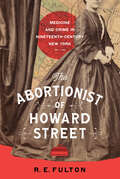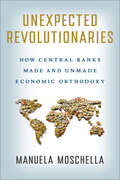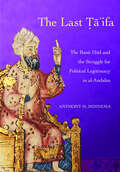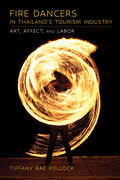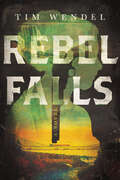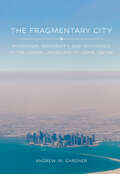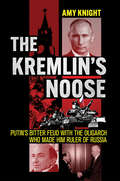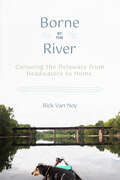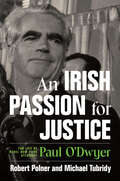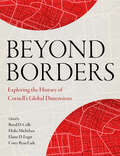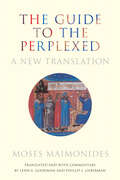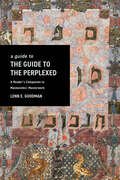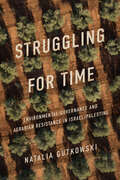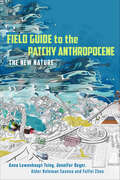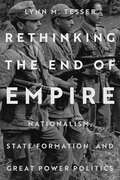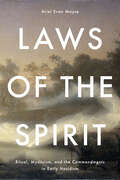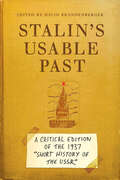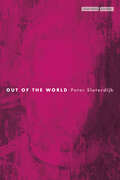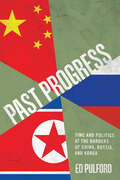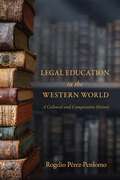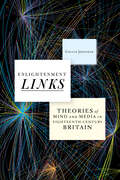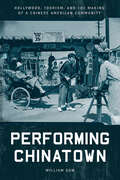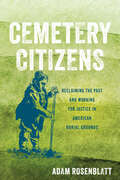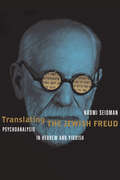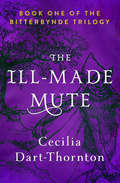- Table View
- List View
The Abortionist of Howard Street: Medicine and Crime in Nineteenth-Century New York
by R.E. FultonJosephine McCarty had many identities. But in Albany, New York, she was known as "Dr. Emma Burleigh," the abortionist of Howard Street.On January 17, 1872, McCarty boarded a streetcar in Utica, New York, shot her ex-lover in the face, and disembarked, unaware that her bullet had passed through her target's head and into the heart of the innocent man sitting beside him. The unlucky passenger died within minutes. Josephine McCarty was arrested for attempted murder and quickly became the most notorious woman in central New York. The Abortionist of Howard Street was, however, far more than a murderer. In Maryland she was "Johnny McCarty," a blockade runner and spy for Confederate forces. New Yorkers whispered of her as a mistress to corrupt Albany politicians. So who was she?The prosecution in her murder trial claimed she was a calculating and heartless operative both in the bedroom and in her public life. Or was she the victim of ill fortune and the systemic weight of misogyny and male violence? The answer, of course, was not as simple as either narrative. In this absorbing and rich history, R.E. Fulton considers the nuances of Josephine McCarty's life from marriage to divorce, from financial abuse to quarrels with intimate partners and more, trying to decipher the truth behind the stories and myths surrounding McCarty and what ultimately led her to that Utica streetcar with a pistol in her dress pocket. In The Abortionist of Howard Street, Fulton revisites a rich history of women's experience in mid-nineteenth century America, revealing McCarty as a multifaceted, fascinating personification of issues as broad as reproductive health, education, domestic abuse, mental illness, and criminal justice.
Unexpected Revolutionaries: How Central Banks Made and Unmade Economic Orthodoxy (Cornell Studies in Money)
by Manuela MoschellaIn Unexpected Revolutionaries, Manuela Moschella investigates the institutional transformation of central banks from the 1970s to the present. Central banks are typically regarded as conservative, politically neutral institutions that uphold conventional macroeconomic wisdom. Yet in the wake of the 2008 global financial crisis and the 2020 COVID-19 crisis, central banks have upended observer expectations by implementing largely unknown and unconventional monetary policies. Far from abiding by well-established policy playbooks, central banks now engage in practices such as providing liquidity support for a wide range of financial institutions and quantitative easing. They have even stretched the remit of monetary policy into issues such as inequality and climate change. Moschella argues that the political nature of central banks lies at the heart of these transformations. While formally independent, central banks need political support to justify their policies and powers, and to obtain it, they carefully manage their reputation among their audienceselected officials, market actors, and citizens. Challenged by reputational threats brought about by twenty-first-century recessionary and deflationary forces, central banks such as the Federal Reserve System and the European Central Bank strategically deviated from orthodox monetary policies to preempt or manage political backlash and to regain public trust. Central banks thus evolved into a new role only in coordination with fiscal authorities and on the back of public contestation. Eye-opening and insightful, Unexpected Revolutionaries is necessary reading for discussions on the future of the neoliberal macroeconomic regime, the democratic oversight of monetary policymaking, and the role that central banks canor cannotplay in our domestic economies.
The Last Ta'ifa: The Banu Hud and the Struggle for Political Legitimacy in al-Andalus (Medieval Societies, Religions, and Cultures)
by Anthony H. MinnemaIn The Last Ta'ifa, Anthony H. Minnema shows how the Banu Hud, an Arab dynasty from Zaragoza, created and recreated their vision of an autonomous city-state (ta'ifa) in ways that reveal changes to legitimating strategies in al-Andalus and across the Mediterranean. In 1110, the Banu Hud lost control of their emirate in the north of Iberia and entered exile, ending their century-long rule. But far from accepting their fate, the dynasty adapted by serving Christian kings, nurturing rebellions, and carving out a new state in Murcia to recover, maintain, and grow their power. By tracing the Banu Hud across chronicles, charters, and coinage, Minnema shows how dynastic leaders borrowed their rivals' claims and symbols and engaged in similar types of military campaigns and complex alliances in an effort to cultivate authority. Drawing on Arabic, Latin, and vernacular sources, The Last Ta'ifa uses the history of the Banu Hud to connect the pursuit of legitimacy in al-Andalus to the politics of other emerging kingdoms and emirates. The actions of Hudid leaders, Minnema shows, echoed across the region as other kings, rebels, and adventurers employed parallel methods to gain power and resist the forces of centralization, highlighting the constructed nature of legitimacy in al-Andalus and the Mediterranean.
Fire Dancers in Thailand's Tourism Industry: Art, Affect, and Labor
by Tiffany Rae PollockFire Dancers in Thailand's Tourism Industry explores the evolution of fire dancing from informal community jam sessions into the iconic, tourist-oriented performances at beach parties and bars, through a close consideration of the role of affect in the lives of fire dancers in the ever-changing scene. Rather than pursuing the common notion that tourism industries are exploitative enterprises that oppress workers, Tiffany Rae Pollock centers the perspectives of fire artists themselves, who view the industry as simultaneously generative and destructive. Dancers reveal how they employ affect to navigate their lives, art, and labor in this context, showcasing how affect is not only a force that acts on people but also is used and shaped by social actors toward their own ends. Fire Dancers in Thailand's Tourism Industry highlights men as affective laborers, investigating how they manage the eroticization of their identities and the intersections of art and labor in tourist economies. Exploring moments of performance and everyday life, Pollock examines how fire artists reimagine their labor, lives, and communities in Thailand's tourism industry.
Rebel Falls: A Novel
by Tim WendelWith Rebel Falls, Tim Wendel takes us to late summer of 1864. The Civil War rages on. Sherman is marching on Atlanta, while the armies of Grant and Lee battle across Virginia. In the North, war-weariness has made Lincoln's bid for reelection seem doubtful. As the fate of the nation "conceived in Liberty" hangs in the balance, Confederate agents gather in Niagara Falls to plan one last audacious maneuver to turn the tide of the conflict. Rory Chase, a capable yet haunted young woman eager to contribute to the Union cause, accepts a mission from the Secretary of State, William Seward, to travel to Niagara Falls and prevent two rebel spies, John Yates Beall and Bennet Burley, from seizing the U.S.S. Michigan on Lake Erie and bombarding Buffalo, Cleveland, and other northern cities to sow fear and disorder ahead of the upcoming election. To succeed, Rory must gain the rebel spies' trust and, with the help of the Underground Railroad network still operating out of the elegant Cataract House hotel overlooking the Falls, foil their desperate gambit. But can she maintain the pretense of being a Confederate sympathizer long enough to unravel Beall and Burley's ingenious plot?With actual events underpinning the tumultuous story in Rebel Falls, a forgotten chapter in the history of the Civil War is revealed. Far from frontlines, Wendel's exciting, character-driven narrative about a consequential struggle in the shadow of Niagara Falls' dramatic beauty is gripping from start to finish.
The Fragmentary City: Migration, Modernity, and Difference in the Urban Landscape of Doha, Qatar
by Andrew M. GardnerAs Andrew M. Gardner explains in The Fragmentary City, in Qatar and elsewhere on the Arabian Peninsula, nearly nine out of every ten residents are foreign noncitizens. Many of these foreigners reside in the cities that have arisen in Qatar and neighboring states. The book provides an overview of the gulf migration system with its diverse migrant experiences. Gardner focuses on the ways that demography and global mobility have shaped the city of Doha and the urban characteristics of the Arabian Peninsula in general. Building on those migrant experiences, the book turns to the spatial politics of the modern Arabian city, exploring who is placed where in the city and how this social landscape came into historical existence. The author reflects on what we might learn from these cities and the societies that inhabit them. In The Fragmentary City, Andrew M. Gardner frames the contemporary cities of the Arabian Peninsula not as poor imitations of Western urban modernity, but instead as cities on the frontiers of a global, neoliberal, and increasingly urban future.
The Kremlin's Noose: Putin's Bitter Feud with the Oligarch Who Made Him Ruler of Russia (NIU Series in Slavic, East European, and Eurasian Studies)
by Amy KnightIn The Kremlin's Noose Amy Knight tells the riveting story of Vladimir Putin and the oligarch Boris Berezovsky, who forged a relationship in the early years of the Yeltsin era. Berezovsky later played a crucial role in Putin's rise to the Russian presidency in March 2000. When Putin began dismantling Boris Yeltsin's democratic reforms, Berezovsky came into conflict with the new Russian leader by reproaching him publicly. Their relationship quickly disintegrated into a bitter feud played out against the backdrop of billion-dollar financial deals, Kremlin in-fighting, and international politics. Dubbed the "Godfather of the Kremlin" by the slain Russian-American journalist Paul Klebnikov, Berezovsky was a successful businessman and media mogul who had an outsized role in Russia after 1991. Worth a reported $3 billion by 1997, Berezovsky engineered the reelection of Yeltsin as president in 1996 and negotiated an end to the 1995–96 Chechen war. Despite his own wealth, power, and influence, once he became Putin's enemy, Berezovsky was forced into exile in Britain, where he waged a determined campaign to topple Putin. Kremlin authorities responded with bogus criminal charges and demanded Berezovsky's extradition. Death threats soon followed. In March 2013, after losing a British court battle with another Russian oligarch, Berezovsky was found dead at his ex-wife's mansion outside London. Whether he died from suicide or murder remains a mystery.The Kremlin's Noose sheds crucial new light on the Kremlin's volatile politics under Yeltsin and Putin, helping us understand why democracy in Russia failed so badly. Knight provides a fascinating narrative of Putin's rise to power and his authoritarian rule, told through the prism of his relationship with Russia's once most powerful oligarch, Boris Berezovsky.
Borne by the River: Canoeing the Delaware from Headwaters to Home
by Rick Van NoyAfter a near-fatal stroke and a separation, amidst a global pandemic, Rick Van Noy decided to go for a paddle. In Borne by the River, he charts the story of discovery, and healing that came from this solo canoe journey. Paddling two hundred miles on the Delaware River to his boyhood home just upriver from Trenton, New Jersey, Van Noy contemplates his fate and life, as well as the simple joy of sitting in a small boat floating down a large river with his dog, Sully.Deftly combining memoir, natural and local history, and engaging reportage of his encounters with other paddlers and river enthusiasts, including members of the Lenape Nation of Pennsylvania, Van Noy reveals deep and shifting layers of environmental, historical, cultural, and personal significance of the Delaware. Borne by the River reckons with the way that rivers braid into one's own life—thrilling rapids, eddying pauses, and life-changing rifts and falls. Van Noy rediscovers and shares how river journeys can scatter anxieties, wash away regrets, and recreate the spirit in its free-flowing currents.
An Irish Passion for Justice: The Life of Rebel New York Attorney Paul O'Dwyer
by Robert Polner Michael TubridyAn Irish Passion for Justice reveals the life and work of Paul O'Dwyer, the Irish-born and quintessentially New York activist, politician, and lawyer who fought in the courts and at the barricades for the rights of the downtrodden and the marginalized throughout the 20th century.Robert Polner and Michael Tubridy recount O'Dwyer's legal crusades, political campaigns, and civic interactions, deftly describing how he cut a principled and progressive path through New York City's political machinery and America's reactionary Cold War landscape. Polner and Tubridy's dynamic, penetrating depiction showcases O'Dwyer's consistent left-wing politics and defense of accused Communists in the labor movement, which exposed him to sharp criticism within and beyond the Irish-American community. Even so, his fierce beliefs, loyalty to his brother William, who was the city's mayor after World War II, and influence in Irish-American circles also inspired respect and support. Recognized by his gentle brogue and white pompadour, he fought for the creation of Israel, organized Black voters during the Civil Rights movement, and denounced the Vietnam War as an insurgent Democratic candidate for US Senate. Finally, he enlisted future president Bill Clinton to bring an end to the Troubles in Northern Ireland. As the authors demonstrate, O'Dwyer was both a man of his time and a politician beyond his years.An Irish Passion for Justice tells an enthralling and inspiring New York immigrant story that uncovers how one person, shaped by history and community, can make a difference in the world by holding true to their ideals.
Beyond Borders: Exploring the History of Cornell's Global Dimensions
by Royal D. Colle, Heike Michelsen, Elaine D. Engst and Corey Ryan EarleBeyond Borders highlights and celebrates Cornell University's many historical achievements in international activities going back to its founding. This collection of fifty-eight short chapters reflects the diversity, accomplishments, and impact of remarkable engagements on campus and abroad. These vignettes, many written by authors who played pivotal roles in Cornell's international history, take readers around the world to China and the Philippines with agricultural researchers, to Peru with anthropologists, to Qatar and India with medical practitioners, to Eastern Europe with economists and civil engineers, to Zambia and Sierra Leone with students and Peace Corps volunteers, and to many more places. Readers also will learn about Cornell's many international dimensions on campus, including the international studies and language programs and the library and museum collections. Beyond Borders captures how—by educating generations of global citizens, producing innovative research and knowledge, building institutional capacities, and forging mutually beneficial relationships—Cornell University has influenced positive change in the world.Beyond Borders was supported by CAPE (Cornell Academics and Professors Emeriti).
The Guide to the Perplexed: A New Translation
by Moses MaimonidesA landmark new translation of the most significant text in medieval Jewish thought. Written in Arabic and completed around 1190, the Guide to the Perplexed is among the most powerful and influential living texts in Jewish philosophy, a masterwork navigating the straits between religion and science, logic and revelation. The author, Rabbi Moses ben Maimon, commonly known as Maimonides or as Rambam, was a Sephardi Jewish philosopher, jurist, and physician. He wrote his Guide in the form of a letter to a disciple. But the perplexity it aimed to cure might strike anyone who sought to square logic, mathematics, and the sciences with biblical and rabbinic traditions. In this new translation by philosopher Lenn E. Goodman and historian Phillip I. Lieberman, Maimonides' warm, conversational voice and clear explanatory language come through as never before in English. Maimonides knew well the challenges facing serious inquirers at the confluence of the two great streams of thought and learning that Arabic writers labeled 'aql and naql, reason and tradition. The aim of the Guide, he wrote, is to probe the mysteries of physics and metaphysics. But mysteries, to Maimonides, were not conundrums to be celebrated for their obscurity. They were problems to be solved. Maimonides' methods and insights resonate throughout the work of later Jewish thinkers, rationalists, and mystics, and in the work of philosophers like Thomas Aquinas, Spinoza, Leibniz, and Newton. The Guide continues to inspire inquiry, discovery, and vigorous debate among philosophers, theologians, and lay readers today. Goodman and Lieberman's extensive and detailed commentary provides readers with historical context and philosophical enlightenment, giving generous access to the nuances, complexities, and profundities of what is widely agreed to be the most significant textual monument of medieval Jewish thought, a work that still offers a key to those who hope to harmonize religious commitments and scientific understanding.
A Guide to The Guide to the Perplexed: A Reader’s Companion to Maimonides’ Masterwork
by Lenn GoodmanIn this volume, noted philosopher Lenn E. Goodman shares the insights gained over a lifetime of pondering the meaning and purpose of Maimonides' celebrated Guide to the Perplexed. Written in the late twelfth century, Maimonides' Guide aims to help religiously committed readers who are alive to the challenges posed by reason and the natural sciences to biblical and rabbinic tradition. Keyed to the new translation and commentary by Lenn E. Goodman and Phillip I. Lieberman, this volume follows Maimonides' life and learning and delves into the text of the Guide, clearly explaining just what Maimonides means by identifying the Talmudic Ma'aseh Bereshit and Ma'aseh Merkavah with physics and metaphysics (to Maimonides, biblical cosmology and theology). Exploring Maimonides' treatments of revelation, religious practice and experience, law and ritual, the problem of evil, and the rational purposes of the commandments, this guide to the Guide explains the tactics Maimonides deployed to ensure that readers not get in over their heads when venturing into philosophical deep waters.
Struggling for Time: Environmental Governance and Agrarian Resistance in Israel/Palestine
by Natalia GutkowskiStruggling for Time examines how time is used as a mechanism of control by the Israeli state and a site of mundane resistance among Palestinian agriculture professionals. Natalia Gutkowski unpacks power structures to show how a settler society lays moral claim on indigenous time through agrarian environmental policies, science, technologies, landscapes, and bureaucracy. Shifting the analysis of Israel/Palestine from land and space to time, she offers new insight into the operation of power in agrarian environments and develops a contemporary framework to understand land and resource grabs under temporal justifications. Traveling across both policymaking arenas and Palestinian citizens' agrarian fields, Gutkowski follows the multiple ways that state officials, agronomists, planners, environmentalists, and agriculturalists use time as a tool of collective agency. Through investigations of wetland drainage in Galilee, transformations in olive agriculture, sustainable agrarian development, and regulation of the shmita biblical commandment, the "year of release" for agricultural fields, this work highlights how Palestinian citizens' agriculture has become a site for the state to settle and mediate time conflicts to justify its existence. As Struggling for Time demonstrates, time politics will take on ever greater urgency as societies and governments plan for an uncertain future in our era of climate change.
Field Guide to the Patchy Anthropocene: The New Nature
by Anna Lowenhaupt Tsing Jennifer Deger Alder Keleman Saxena Feifei ZhouNature has gone feral. How can we re-attune ourselves to the new nature? A field guide can help. While the global scientific community recently made headlines by ruling the Anthropocene—an era many date to the Industrial Revolution when human action truly began to transform the planet—did not qualify for a geological epoch quite yet, understanding the nature of human transformation of the Earth is more important than ever. The effects of human activity are global in scope, but take shape within distinct social and ecological "patches," discontinuous regions within which the key actors may not be human, but the plants, animals, fungi, viruses, plastics, and chemicals creating our new world. Field Guide to the Patchy Anthropocene takes stock of our current planetary crisis, leading readers through a series of sites, thought experiments, and genre-stretching descriptive practices to nurture a revitalized natural history. Field guides teach us how to notice, name, and so better appreciate more-than-human worlds. They hone our powers of observation and teach us to see the world anew. Field-based observations and place-based knowledge cultivation—getting up-close and personal with patchy dynamics—are vital to truly grapple with the ecological challenges and the historical conjunctures that are bringing us to multiple catastrophic tipping points. How has commercial agriculture runoff given rise to comb jellies in the Black Sea? What role did the Atlantic slave trade play in the worldwide spread of virus-carrying mosquitoes? How did the green revolution transform the brown planthopper into a superpredator in Philippine rice fields? Questions like these open up new ways of understanding, and ways of living through, the epoch that human activity has ushered in. This Field Guide shifts attention away from knowledge extractive practices of globalization to encourage skilled observers of many stripes to pursue their commitments to place, social justice, and multispecies community. It is through attention to the beings, places, ecologies, and histories of the Anthropocene that we can reignite curiosity, wonder, and care for our damaged planet.
Rethinking the End of Empire: Nationalism, State Formation, and Great Power Politics
by Lynn M. TesserWhy did a nation-state order emerge when nationalist activism was usually an elitist pursuit in the age of empire? Ordinary inhabitants and even most indigenous elites tended to possess religious, ethnic, or status-based identities rather than national identities. Why then did the desires of a typically small number result in wave after wave of new states? The answer has customarily centered on the actions of "nationalists" against weakening empires during a time of proliferating beliefs that "peoples" should control their own destiny. This book upends conventional wisdom by demonstrating that nationalism often existed more in the perceptions of external observers than of local activists and insurgents. Lynn M. Tesser adds nuance to scholarship that assumes most, if not all, pre-independence unrest was nationalist and separatist, and sheds light on why the various demands for change eventually coalesced around independence in some cases but not others.
Laws of the Spirit: Ritual, Mysticism, and the Commandments in Early Hasidism (Stanford Studies in Jewish History and Culture)
by Ariel Evan MayseThe compelling vision of religious life and practice found in Hasidic sources has made it the most enduring and successful Jewish movement of spiritual renewal of all time. In this book, Ariel Evan Mayse grapples with one of Hasidism's most vexing questions: how did a religious movement known for its radical views about immanence, revelation, and the imperative to serve God with joy simultaneously produce strict adherence to the structures and obligations of Jewish law? Exploring the movement from its emergence in the mid-1700s until 1815, Mayse argues that the exceptionality of Hasidism lies not in whether its leaders broke or upheld rabbinic norms, but in the movement's vivid attempt to rethink the purpose of Jewish ritual and practice. Rather than focusing on the commandments as law, he turns to the methods and vocabulary of ritual studies as a more productive way to reckon with the contradictions and tensions of this religious movement as well as its remarkable intellectual vitality. Mayse examines the full range of Hasidic texts from the eighteenth and early nineteenth centuries, from homilies and theological treatises to hagiography, letters, and legal writings, reading them together with contemporary theories of ritual. Arguing against the notion that spiritual integrity requires unshackling oneself from tradition, Laws of the Spirit is a sweeping attempt to rethink the meaning and significance of religious practice in early Hasidism.
Stalin's Usable Past: A Critical Edition of the 1937 Short History of the USSR (Stanford–Hoover Series on Authoritarianism)
by David BrandenbergerAt the height of the Great Terror in 1937, Joseph Stalin took a break from the purges to edit a new textbook on the history of the USSR. Published shortly thereafter, the Short History of the USSR amounted to an ideological sea change. Stalin had literally rewritten Russo-Soviet History, breaking with two decades of Bolshevik propaganda that styled the 1917 Revolution as the start of a new era. In its place, he established a thousand-year pedigree for the Soviet state that stretched back through the Russian empire and Muscovy to the very dawn of Slavic civilization. Appearing in million-copy print runs through 1955, the Short History transformed how a generation of Soviet citizens were to understand the past, not only in public school and adult indoctrination courses, but on the printed page, the theatrical stage, and the silver screen. Stalin's Usable Past supplies a critical edition of the Short History that both analyzes the text and places it in historical context. By highlighting Stalin's precise redactions and embellishments, historian David Brandenberger reveals the scope of Stalin's personal involvement in the textbook's development, documenting in unprecedented detail his plans for the transformation of Soviet society's historical imagination.
Out of the World (Cultural Memory in the Present)
by Peter SloterdijkIn this essential early work, the preeminent European philosopher Peter Sloterdijk offers a cross-cultural and transdisciplinary meditation on humanity's tendency to refuse the world. Developing the first seeds of his anthropotechnics, Sloterdijk theorizes consciousness as a medium, tuned and retuned over the course of technological and social history. His subject here is the "world-alien" (Weltfremdheit) in man that was formerly institutionalized in religions, but is increasingly dealt with in modern times through practices of psychotherapy. Originally written in 1993, this almost clairvoyant work examines how humans seek escape from the world in cross-cultural and historical context, up to the mania and world-escapism of our cybernetic network culture. Chapters delve into artificial habitats and forms of intoxication, from early Christian desert monks to pharmaco-theology through psychedelics. In classic form, Sloterdijk recalibrates and reinvents concepts from the ancient Greeks to Heidegger to develop an astonishingly contemporary philosophical anthropology.
Past Progress: Time and Politics at the Borders of China, Russia, and Korea
by Ed PulfordWhile anxiety abounds in the old Cold War West that progress – whether political or economic – has been reversed, for citizens of former-socialist countries, murky temporal trajectories are nothing new. Grounded in the multiethnic frontier town of Hunchun at the triple border of China, Russia, and North Korea, Ed Pulford traces how several of global history's most ambitiously totalizing progressive endeavors have ended in cataclysmic collapse here. From the Japanese empire which banished Qing, Tsarist, and Choson dynastic histories from the region, through Chinese, Soviet, and Korean socialisms, these borderlands have seen projections and disintegrations of forward-oriented ideas accumulate on a grand scale. Taking an archaeological approach to notions of historical progress, the book's three parts follow an innovative structure moving backwards through linear time. Part I explores "post-historical" Hunchun's diverse sociopolitics since high socialism's demise. Part II covers the socialist era, discussing cross-border temporal synchrony between China, Russia, and North Korea. Finally, Part III treats the period preceding socialist revolutions, revealing how the collapse of Qing, Tsarist, and Choson dynasties marked a compound "end of history" which opened the area to projections of modernity and progress. Examining a borderland across linguistic, cultural, and historical lenses, Past Progress is a simultaneously local and transregional analysis of time, borders, and the state before, during, and since socialism.
Legal Education in the Western World: A Cultural and Comparative History
by Rogelio Pérez-PerdomoLegal Education in the Western World provides an encompassing history of legal education from Ancient Rome to present day Europe and the Americas. Legal education is considered the locus of the formation of professional culture, and in this book Rogelio Pérez-Perdomo contributes to our understanding of its formation by paying attention to how legal knowledge is conceived, the way it is created and transmitted, and the social status of masters, professors, teachers, apprentices and students. He focuses on historical periods and societies that have influenced the current state of legal education. While these are established touchpoints used by historians and supported by a vast bibliographies in English, Spanish, French, Italian and Portuguese, this book also includes material often overlooked by historians. Ultimately, this concise and accessible history presents a panoramic view that highlights the strengths and weaknesses of approaches to legal education in different societies, and an examination of the shared idea of law manifested in them. This historical and comparative perspective will be useful to comparative legal scholars and legal historians interested in a more informed general approach to improving legal education.
Enlightenment Links: Theories of Mind and Media in Eighteenth-Century Britain (Stanford Text Technologies)
by Collin JenningsIn this ambitious work, Collin Jennings applies computational methods to eighteenth-century fiction, history, and poetry to reveal the nonlinear courses of reading they produce. Hallmark genres of the British Enlightenment, such as the novel and the stadial history, are typically viewed as narratives of linear progress, emerging from Britain's imperial growth and scientific advancement. Jennings foregrounds Enlightenment links: the paratextual devices, including cross-references, footnotes, and epigraphs, that make words work differently by pointing the reader to places inside and outside the text. Writers and printers combined text and paratext to produce nonlinear paths of reading and polysemous forms of reference that resist simple, causal structures of experience or theories of mind. Alexander Pope, Adam Smith, Ann Radcliffe, and other writers developed genres that operate diagrammatically, with different points of entry and varied relationships between the language and format of books. Revealing the eighteenth-century genealogy of the digital hyperlinks of today, Enlightenment Links argues that emergent print genres combined language and links to bring forward the associative, circular, and multi-sequential ways in which literature makes language work.
Performing Chinatown: Hollywood, Tourism, and the Making of a Chinese American Community (Asian America)
by William GowIn 1938, China City opened near downtown Los Angeles. Featuring a recreation of the House of Wang set from MGM's The Good Earth, this new Chinatown employed many of the same Chinese Americans who performed as background extras in the 1937 film. Chinatown and Hollywood represented the two primary sites where Chinese Americans performed racial difference for popular audiences during the Chinese exclusion era. In Performing Chinatown, historian William Gow argues that Chinese Americans in Los Angeles used these performances in Hollywood films and in Chinatown for tourists to shape widely held understandings of race and national belonging during this pivotal chapter in U.S. history. Performing Chinatown conceives of these racial representations as intimately connected to the restrictive immigration laws that limited Chinese entry into the U.S. beginning with the 1875 Page Act and continuing until the passage of the Immigration and Nationality Act of 1965. At the heart of this argument are the voices of everyday people including Chinese American movie extras, street performers, and merchants. Drawing on more than 40 oral history interviews as well as research in more than a dozen archival and family collections, this book retells the long-overlooked history of the ways that Los Angeles Chinatown shaped Hollywood and how Hollywood, in turn, shaped perceptions of Asian American identity.
Cemetery Citizens: Reclaiming the Past and Working for Justice in American Burial Grounds
by Adam RosenblattAcross the United States, groups of grassroots volunteers gather in overgrown, systemically neglected cemeteries. As they rake, clean headstones, and research silenced histories, they offer care to individuals who were denied basic rights and forms of belonging in life and in death. Cemetery Citizens is the first book-length study of this emerging form of social justice work. It focuses on how racial disparities shape the fates of the dead, and asks what kinds of repair are still possible. Drawing on interviews, activist anthropology, poems, and drawings, Adam Rosenblatt takes us to gravesite reclamation efforts in three prominent American cities. Cemetery Citizens dives into the ethical quandaries and practical complexities of cemetery reclamation, showing how volunteers build community across social boundaries, craft new ideas about citizenship and ancestry, and expose injustices that would otherwise be suppressed. Ultimately, Rosenblatt argues that an ethic of reclamation must honor the presence of the dead—treating them as fellow cemetery citizens who share our histories, landscapes, and need for care.
Translating the Jewish Freud: Psychoanalysis in Hebrew and Yiddish (Stanford Studies in Jewish History and Culture)
by Naomi SeidmanThere is an academic cottage industry on the "Jewish Freud," aiming to detect Jewish influences on Freud, his own feelings about being Jewish, and suppressed traces of Jewishness in his thought. This book takes a different approach, turning its gaze not on Freud but rather on those who seek out his concealed Jewishness. What is it that propels the scholarly aim to show Freud in a Jewish light? Naomi Seidman explores attempts to "touch" Freud (and other famous Jews) through Jewish languages, seeking out his Hebrew name or evidence that he knew some Yiddish. Tracing a history of this drive to bring Freud into Jewish range, Seidman also charts Freud's responses to (and jokes about) this desire. More specifically, she reads the reception and translation of Freud in Hebrew and Yiddish as instances of the desire to touch, feel, "rescue," and connect with the famous Professor from Vienna.
The Ill-Made Mute: Special Edition (The Bitterbynde Trilogy #1)
by Cecilia Dart-ThorntonIn a dark and perilous realm, a nameless outcast seeks a voice, a past, and a future: &“A dazzling debut&” (Jennifer Roberson). In all of Erith, there is perhaps no one as wretched as the nameless mute foundling confined to the lowest depths of Isse Tower. Abused by many and despised by all, the pathetic creature lives without memories in the shadows. The amnesiac longs to escape—to roam the wild landscape in search of a past, a name, a destiny—but dangers surround the tower. Only flying ships and majestic winged horses carrying important visitors can reach the castle safely, landing high above the ground on its battlements. The local servants whisper about malevolent creatures that roam the forests and bear no love for humankind. Escape seems impossible in this treacherous world of wights and monsters. Praised as Australia&’s J. R. R. Tolkien, Cecilia Dart-Thornton has set a towering new standard for fantasy fiction, earning the respect and acclaim of readers, reviewers, and some of the world&’s most renowned fantasists. With roots firmly embedded in the ancient folklore of the British Isles, The Ill-Made Mute—the opening volume of Dart-Thornton&’s magnificent Bitterbynde Trilogy—introduces fantasy lovers to an unforgettable character whose remarkable adventures rival the epic trials of the Bagginses and the tales of The Silmarillion.
